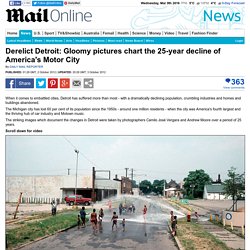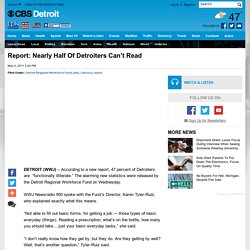

Michigan Orders Detroit Finances to Be Reviewed. Marilyn Salenger: ‘White flight’ and Detroit’s decline. By Marilyn Salenger By Marilyn Salenger July 21, 2013 Marilyn Salenger is president of Strategic Communications Services and a former correspondent and news anchor for several CBS stations.

An almost palpable sadness has swept across the country at the news that the city of Detroit has filed for bankruptcy. While the possibility of this had been discussed, the reality of what was once the fourth-largest city in the United States sinking to such depths is disheartening, a moment people will remember for years to come. To understand that the decline and bankruptcy represent so much more than dollars and cents requires a step back to a time that many would prefer to forget but remains unforgettable. For Detroit, a Crisis Born of Bad Decisions and False Hope. Kwame M. Kilpatrick, Former Detroit Mayor, Sentenced to 28 Years in Corruption Case. RACE - The Power of an Illusion . Go Deeper. How Does a Good Neighborhood "Turn Bad"?

What triggers the decline of an area? Some people claim that once minorities move in, the neighborhood starts to deteriorate. There is a chain of events that will cause even the most affluent area to become an impoverished one. But it's not about who's moving in - it's about who leaves. One thing leads to another… White Flight Begins When nonwhite residents (particularly Black and Latino) begin moving into a neighborhood, white homebuyers "perceive" that the neighborhood is in decline and choose not to move there. CONCLUSION Every family wants the best neighborhood they can afford. Race does play a role, but it's not the one people think. Detroit Is an Example of Everything That Is Wrong with Our Nation. Back on July 18, 2013 the city of Detroit filed for Chapter 9 bankruptcy.

Detroit is now seeing a little life, but the city is far from where it once was. Once the wealthiest city in America, known as the “arsenal of democracy,” Detroit was the fourth largest city in the U.S. in the 1960s with a population of two million. Now it has become an example of everything that is wrong with the American economy, Detroit has become nothing more than a devastated landscape of urban decay with a current population of 714,000 whose unemployment rate at the height of the recession was as high as 29 percent, and has only decreased due to the rapidly decreasing population. Visiting Detroit is the closest Americans can come to viewing what appears to be a war-torn city without leaving the U.S.
This former powerhouse is a barren stretch of land, devastated by looters and and full of run-down, vacant houses. Detroit's amazing transformation captured on camera after it loses ONE MILLION residents in 60 years. By Daily Mail Reporter Published: 01:28 GMT, 2 October 2012 | Updated: 20:28 GMT, 3 October 2012 When it comes to embattled cities, Detroit has suffered more than most - with a dramatically declining population, crumbling industries and homes and buildings abandoned.

The Michigan city has lost 60 per cent of its population since the 1950s - around one million residents - when the city was America's fourth largest and the thriving hub of car industry and Motown music. The striking images which document the changes in Detroit were taken by photographers Camilo José Vergara and Andrew Moore over a period of 25 years. Detroit is "Most Dangerous City in America" for fourth year in a row, Forbes report says. (CBS) DETROIT - For the fourth year in a row, Forbes magazine is calling Detroit the "Most Dangerous City in America," citing statistics from the FBI's Uniform Crime Report, according to CBS Detroit.

Pictures: America's Ten Most Dangerous Cities A high murder rate helped make the Motor City the U.S. metropolitan area most prone to violent crime in 2010, with 1,111 violent crimes reported per 100,000 residents, Forbes reported. The magazine compiled its data using the FBI data for 2010 for each of the country's metropolitan regions in four categories of violent crimes: murder and non-negligent manslaughter, forcible rape, robbery and aggravated assault. Renee Monforton, of the Detroit Metro Convention & Visitors Bureau, downplayed the "distinction": "There is crime, it's typically centered in pockets, where there might be a lot of poverty, unfortunately, or perhaps from not so many educational opportunities," said Monforton.
The World Series will be coming to Detroit this week. Financial manager: Detroit 'dysfunctional, wasteful' DETROIT — Detroit's emergency manager said Monday that he'll know in as soon as six weeks whether the city's financial crisis can be resolved without declaring bankruptcy.

The city will finish its current budget year with a $162 million cash-flow shortfall and doubts about the financial health of its pension funds, according to a new report by emergency manager Kevyn Orr that lays out the financial free fall in stark detail. STORY: Governor picks Detroit emergency manager "We'll get a gauge on whether we have a true partner for an out-of court solution in that sort of time frame," Orr on the day he released the critical report. The report, mandated by the state after an emergency manager's first 45 days in office, confirms a city in desperate shape, with costs for retiree benefits eating up a third of its budget and public services suffering as Detroit's revenues and population shrink each year.
"It may take actually longer to get through the process," Orr said. Anatomy of Detroit’s Decline - Interactive Feature. Mayor Coleman A. Young of Detroit at an event in 1980. Richard Sheinwald/Associated Press The financial crisis facing Detroit was decades in the making, caused in part by a trail of missteps, suspected corruption and inaction. Here is a sampling of some city leaders who trimmed too little, too late and, rather than tackling problems head on, hoped that deep-rooted structural problems would turn out to be cyclical downturns.
Charles E. Edward Jeffries, who served as mayor from 1940 to 1948, developed the Detroit Plan, which involved razing 100 blighted acres and preparing the land for redevelopment. Albert Cobo was considered a candidate of the wealthy and of the white during his tenure from 1950 to 1957. Report: Nearly Half Of Detroiters Can’t Read. DETROIT (WWJ) – According to a new report, 47 percent of Detroiters are “functionally illiterate.”

The alarming new statistics were released by the Detroit Regional Workforce Fund on Wednesday. WWJ Newsradio 950 spoke with the Fund’s Director, Karen Tyler-Ruiz, who explained exactly what this means. “Not able to fill out basic forms, for getting a job — those types of basic everyday (things). Reading a prescription; what’s on the bottle, how many you should take… just your basic everyday tasks,” she said. “I don’t really know how they get by, but they do. Some of the Detroit suburbs also have high numbers of functionally illiterate: 34 percent in Pontiac and 24 percent in Southfield.
“For other major urban areas, we are a little bit on the high side… We compare, slightly higher, to Washington D.C.’s urban population, in certain ZIP codes in Washington D.C. and in Cleveland,” she said. Tyler-Ruiz said only 10 percent of those who can’t read have gotten any help to resolve it.